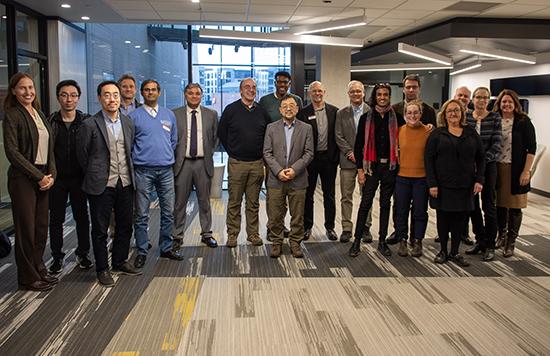
Prof. Claudia Schmidt presents ideas on biomining to visiting officials from ARPA-E, including Program Director Doug Wicks (left)
In February, US Department of Energy Advanced Research Projects Agency-Energy (ARPA-E) officials, including Program Directors Dr. Cory Phillips and Dr. Doug Wicks, visited the University of Minnesota to hear about promising research into sustainable mining and energy technologies and to inform the UMN research community about ARPA-E’s interest in funding disruptive research. ARPA-E advances high-potential, high-impact energy technologies that aren’t yet ready for private-sector investment.
During visits to UMN Duluth, ARPA-E officials, along with National Renewable Energy Laboratory (NREL) representatives, toured the Natural Resources Research Institute (NRRI) to learn more about the institute’s close relationships with the mining industry and the subsequent impact of their cooperative efforts. Officials were able to get a fuller picture of Minnesota’s mining operations, the variety of mining and ore available, and how NRRI research is improving mining and decarbonization efforts.
ARPA-E officials also visited Niron Magnetics to learn more about the UMN startup’s Clean Earth Magnet, which was named a TIME magazine best invention of 2023. During their visit, they saw the installation of the company’s new 300-ton press. ARPA-E was an early supporter of Niron’s technology and awarded the startup $17.5 million under the agency’s SCALEUP program to help it commercialize the Clean Earth Magnet.

On the Twin Cities campus, Vice President for Research and Innovation Shashank Priya gave an overview of UMN research and met with UMN academic leaders, including Deans Andrew Alleyne, Brian Buhr, and Saara DeWalt. Next, ARPA-E Program Director Doug Wicks gave a seminar called “Catalyzing the Renaissance of American Mining to Enable the Energy Transition” about ARPA-E’s research priorities, which include figuring out new ways of mining, to a dozen UMN researchers. Wicks, Program Director Cory Phillips, Dr. Toni Marechaux (ARPA-E Tech SETA), and ARPA-E Fellows Dr. Elise Goldfine and Dr. Jo Melville then had a chance to hear rapid fire talks from seven UMN researchers on promising ideas around energy, mining, material science, and chemical catalysis.


ARPA-E officials also shared advice for researchers who want to be successful awardees and partners. They recommend volunteering to review for ARPA-E to get a better understanding of the program. They encouraged researchers to talk with staff before applying, either through Zoom calls or by pitching at the Annual Energy Innovation Summit. Finally, ARPA-E officials recommended that researchers apply for the ARPA-E Fellowship to get hands-on experience at the agency.